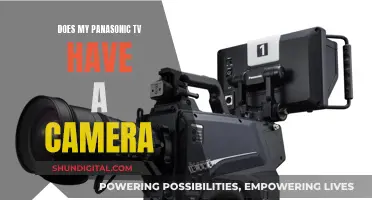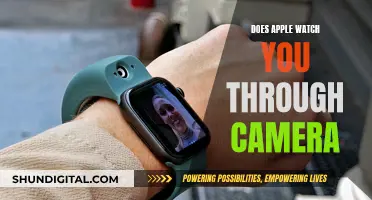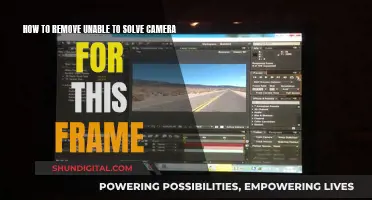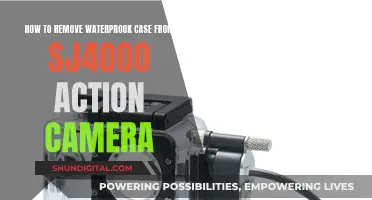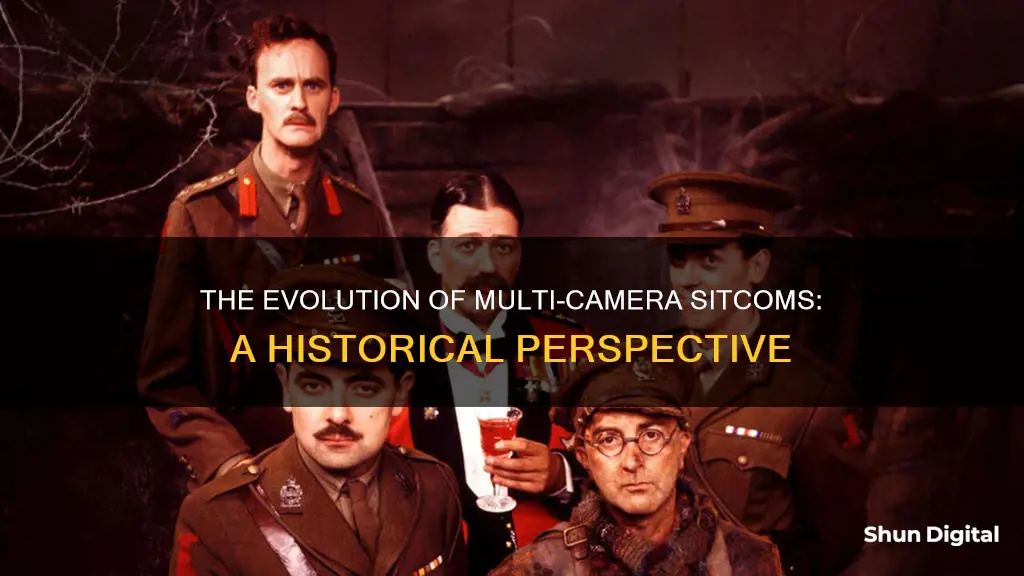
The multi-camera setup is a method of filmmaking, television production, and video production. In television, it is commonly used for sitcoms, especially those filmed before a live studio audience. The first multi-camera TV sitcom was 'I Love Lucy', which pioneered the setup in 1951. The setup consists of multiple cameras capturing different angles of a scene simultaneously, with the outer cameras shooting close-up shots of the most active characters and the central camera capturing a wider master shot. This method reduces the need for reshoots and makes editing easier by reducing continuity issues.
| Characteristics | Values |
|---|---|
| Name of the first multi-camera TV sitcom | I Love Lucy |
| Year of release | 1951 |
| Producers | Desi Arnaz, Al Simon, and Karl Freund |
| Production company | Desilu Productions |
| Number of cameras used | Three |
| Type of cameras used | Film cameras |
| Lighting setup | Compromised to accommodate all camera setups |
| Editing | Easier and reduced continuity issues |
| Number of retakes | Reduced |
| Sound | Wax discs that couldn't be edited |
| Live audience | Yes |
What You'll Learn

The first multi-camera sitcom was likely 'I Love Lucy'
The multi-camera setup is a method of filmmaking, television production, and video production where several cameras are used to capture a scene simultaneously. This is in contrast to a single-camera setup, where one camera is used, and the same camera (or multiple cameras pointed in one direction) is moved and reset to achieve new angles.
The multi-camera setup was likely first used in television production when producer and star Desi Arnaz, associate producer Al Simon, and cinematographer Karl Freund of Desilu Productions employed it to film the sitcom *I Love Lucy* in 1951. However, it should be noted that others had been using the technique for several years prior. For example, Jerry Fairbanks is said to have first developed a 16mm multi-camera system to film the made-for-TV show *Public Prosecutor* in 1947.
I Love Lucy was a standard sitcom that popularized the three-camera system, which is now commonly used for light entertainment, sports events, news, soap operas, talk shows, game shows, variety shows, and sitcoms, especially those filmed before a live studio audience. The multi-camera setup is particularly well-suited for sitcoms, as it is faster and less expensive than single-camera production, and can accommodate the presence of a live audience.
The three-camera system consists of two outer cameras that capture close-up shots of the two most active characters, while a central camera (or cameras) captures a wider master shot to establish the geography of the room. This setup allows for multiple shots to be obtained in a single take, reducing the need for re-lighting and the setup of alternative camera angles, and minimizing the complexity of tracking continuity issues. However, it also has drawbacks, such as a less optimized lighting setup and more complicated equipment placement.
In addition to being the first multi-camera sitcom, *I Love Lucy* also demonstrated the three-camera technique to viewers during *I Love Lucy: The Movie*.
Apple Watch: Camera-less Wrist Essential
You may want to see also

Multi-camera sitcoms are cheaper and faster to produce
The multi-camera setup is a method of filmmaking, television production, and video production that involves employing several cameras to simultaneously record or broadcast a scene. This setup is particularly useful for sitcoms, as it is cheaper and faster to produce than single-camera setups.
Single-camera setups, which are more common in film, require complex lighting setups and time-consuming camera adjustments between shots. In contrast, multi-camera productions can be filmed much faster, as there is no need to reset lighting or camera angles for each shot. This makes multi-camera setups ideal for sitcoms, which often have tight production schedules and require a live audience.
The use of multiple cameras also reduces the time spent in post-production editing. Since all the necessary shots are captured simultaneously, there is less footage to sort through and assemble during editing. This efficiency can significantly reduce the time and cost of production.
While multi-camera setups offer these advantages, there are also some drawbacks. One challenge is optimizing the lighting setup to accommodate all the camera angles. Additionally, positioning equipment, such as microphone booms and lighting rigs, can be more complicated as they need to be hidden from multiple cameras.
Despite these challenges, the multi-camera setup is a popular choice for sitcoms due to its cost-effectiveness and efficiency. It allows producers to work within tight schedules and budgets while delivering a seamless viewing experience for audiences.
The first multi-camera TV sitcom was likely "I Love Lucy," which popularized the three-camera system. Since then, many successful sitcoms have employed this setup, including "The Dick Van Dyke Show," "The Mary Tyler Moore Show," "Seinfeld," and "Friends."
Casting Your S10 Camera to TV: A Simple Guide
You may want to see also

Single-camera sitcoms are more expensive and time-consuming
Multi-camera sitcoms are faster and less expensive to produce. Multiple cameras are used to capture all the different camera angles of a scene simultaneously, and the set is lit to accommodate all camera setups at once. This means there is no need to relight or reset between shots, saving time and money. Multi-camera sitcoms are also usually filmed in front of a live studio audience, which adds to their efficiency.
On the other hand, single-camera sitcoms are more time-consuming and costly. In this setup, all the shots and camera angles are taken using the same camera, or multiple cameras pointed in one direction, which are then moved and reset to get a new angle. This requires more time and resources. Single-camera sitcoms also don't have live studio audiences, which can increase costs and production time.
The single-camera setup gives the director more control over each shot and allows for more complex lighting setups and equipment placement. It also enables the use of specific camera angles and movements that can enhance the visual style of the production. Single-camera sitcoms often have an enhanced visual style and use real-world filming locations, which can add to the expense and time required for production.
While single-camera sitcoms are more expensive and time-consuming, they offer advantages in terms of creative control and visual style. The additional time and cost may be justified by the increased flexibility and enhanced visuals that the single-camera setup provides.
Simplisafe Cameras: Watching or Not?
You may want to see also

Multi-camera sitcoms are filmed in front of a live studio audience
The multi-camera setup is a method of filmmaking, television production and video production. Multiple cameras are used on set and record or broadcast a scene simultaneously. This setup is often used for sitcoms, especially those filmed in front of a live studio audience.
The multi-camera setup is similar to live theatre, with stages set before an audience. The "play" is captured on multiple cameras as actors walk from one set to another, often in a single take. This setup requires a more technical approach in the script format, and the scripts are typically longer than those for single-camera sitcoms.
The multi-camera setup has several drawbacks. For example, the lighting setup is less optimised because it needs to be a compromise for all camera angles. Additionally, it can be more complicated to set up microphone booms and lighting rigs because they need to be hidden from all cameras.
Despite these drawbacks, the multi-camera setup is popular for sitcoms because it allows for faster filming and reduces the time spent in editing. It also enables the inclusion of a live studio audience, which influences the humour and style of the show.
MLB Games: TV Cameras and Their Numbers
You may want to see also

Single-camera sitcoms are more like feature films
Single-camera sitcoms have become increasingly popular in recent years, with shows like Modern Family, Silicon Valley, and The Last Man on Earth. While these shows are often filmed with multiple cameras, they are shot more like a film, without a live audience. This gives them a feature film-like visual style, and the lack of a laugh track means the humour plays out more like a feature comedy.
Single-camera sitcoms are often compared to low-budget independent films, with a more cinematic style of shooting. They tend to have a slower, quieter approach, with more subtle humour that relies on the audience actively finding the funny moments within a scene. This style of comedy is often enhanced by close-up reaction shots that capture the slightest eye roll or facial expression. Single-camera sitcoms also have the advantage of being able to shoot on location, which adds to the sense of the world the show occupies and grounds it in reality.
The single-camera setup gives the director more control over each shot and allows for more complex storylines and larger ensembles of characters. It is also better suited to visual effects and fast-paced action sequences, as seen in the series Get Smart. This style of shooting is more time-consuming and expensive but can result in a more dynamic and visually appealing show.
The multi-camera setup, on the other hand, is faster and less expensive, making it a popular choice for sitcoms. It allows for multiple perspectives to be captured simultaneously, which is essential for recording an ensemble cast performing before a live audience. The multi-camera setup is also more limiting in terms of locations and sets, which can make the show feel more like a stage play.
In conclusion, single-camera sitcoms have a more cinematic feel and offer more creative freedom, while multi-camera sitcoms are more traditional and resemble live theatre. The choice between the two comes down to the specific needs and budget of the production, with single-camera sitcoms usually being more expensive and time-consuming.
Syncing Mini Camera Footage to Your Tablet: A Guide
You may want to see also
Frequently asked questions
The first multi-camera TV sitcom was 'I Love Lucy', which first aired in 1951.
Using multiple cameras allows for the same scene to be captured from different angles simultaneously, reducing the number of times a scene needs to be re-shot and making editing easier by reducing continuity issues.
One of the drawbacks of using multiple cameras is that the lighting setup needs to be a compromise that works for all camera angles. There is also less flexibility when it comes to positioning equipment such as microphone booms and lighting rigs.


